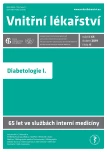The role of GLP-1 receptor agonists and their fixed combination with insulin in the treatment of type 2 diabetes mellitus
Authors:
Zbynek Schroner 1; Vladimír Uličiansky 2
Authors‘ workplace:
SchronerMED, s. r. o., interná a diabetologická ambulancia Košice, Slovenská republika
1; Via medica, s. r. o., Košice, Slovenská republika
2
Published in:
Vnitř Lék 2019; 65(4): 284-288
Category:
Overview
Therapy with GLP1 receptors agonists shows various multiorgans benefits. Possible reasons of preference of this treatment are: efficacy, decrease of weight, CV protectivity, slow down the progression of nephropathy, protection of function of B-cells, safety (low risk of hypoglycemia, small incidence of serious adverse events), decrease of blood pressure, lipids, biomarkers of CV risk, markers of chronic subclinical inflammation. In context of individual approach, therapy with GLP1 receptors agonists should be preferably used in early stages of type 2 diabetes mellitus, as second choice treatment after metformin, mainly in more obese patients with subclinical or clinical manifestations of atherosclerosis, but without symptoms of heart failure.
Keywords:
fixed combination – therapeutic place – type 2 diabetes mellitus
Sources
-
Meier JJ. Differentiation of GLP-1 receptor agonist. Nat Rev Endocrinol 2012; 8(12): 728–742. Dostupné z DOI: <http://dx.doi.org/10.1038/nrendo.2012.140>.
-
Horowitz M, Rayner CK, Jones KL. Mechanisms and clinical efficacy of lixisenatide for the management of type 2 diabetes. Adv Ther. 2013; 30(2): 81–101. Dostupné z DOI: <http://doi: 10.1007/s12325–013–0009–4>.
-
Uličiansky V, Schroner Z, Némethyová Z et al. Personalizovaná medicína v kontexte odporúčaní ADA/EASD 2015. Forum Diab 2015; 4(2): 102–118.
-
Schroner Z, Uličiansky V. Multiorgánové benefity agonistov GLP-1 analógov. Interná Med 2015; 15(4): 175–177.
-
Drucker DJ, Nauck MA. The incretin system: glucagon-like peptide-1 receptor agonists and dipeptidyl peptidase-4 inhibitors in type 2 diabetes. Lancet 2006; 368(9548): 1696–1705. Dostupné z DOI: <http://dx.doi.org/10.1016/S0140–6736(06)69705–5>.
-
Ban K, Kim KH, Kelbaek H et al. Glucagon-like peptide -1 (9–36) amide-mediated cytoprotection is blocked by exendin (9–39) yet does not require the known GLP-1 receptor. Endocrinology 2010; 151(4): 1520–1531. Dostupné z DOI: <http://dx.doi.org/10.1210/en.2009–1197>.
-
Timmers L, Henriques JP, deKleijn DP et al. Exenatide reduces infarct size and improves cardiac function in a porcine model of ischemia and reperfusion injury. J Am Col Card 2009; 53(6): 501–510. Dostupné z DOI: <http://dx.doi.org/10.1016/j.jacc.2008.10.033>.
-
Noyan-Ashraf MH, Momen MA, Ban K et al. GLP-1R agonist liraglutide activates cytoprotective pathways and improves outcomes after experimental myocardial infarction in mice. Diabetes 2009; 58(4): 975–983.Dostupné z DOI: <http://dx.doi.org/10.2337/db08–1193>.
-
Lonborg J, Vejlstup N, Kelbaek H et al. Exenatide reduces reperfusion injury in patients with ST-segment elevation myocardial infarction. Eur Heart J 2012; 33(12): 1491–1499. Dostupné z DOI: <http://dx.doi.org/10.1093/eurheartj/ehr309>.
-
Marso SP, Daniels GH, Brown-Frandsen K et al. Liraglutide and cardiovascular outcomes in patients with type 2 diabetes. N Engl J Med 2016; 375(4): 311–322. Dostupné z DOI: <http://dx.doi.org/10.1056/NEJMoa1603827>.
-
Marso SP, Bain SC, Consoli A et al. Semaglutide and cardiovascular outcomes in patients with type 2 diabetes. N Engl J Med 2016; 375(19); 1834–1844. Dostupné z DOI: <http://dx.doi.org/10.1056/NEJMoa1607141>.
-
Holman RR et al. [EXSCEL Study Group]. Effect of once-weekly exenatide on cardiovascular outcomes in type 2 diabetes. N Engl J Med 2017; 377(13): 1228–1239. Dostupné z DOI: <http://dx.doi.org/10.1056/NEJMoa1612917>.
-
Haluzík M, Schroner Z. Liečba založená na účinku inkretínov a kardiovaskulárne riziko. In: Haluzík M, Schroner Z, Mráz, M et al. Antidiabetiká a kardiovaskuslárne riziko. SchronerMed: Košice 2017. ISBN: 978–80–8129–073–2.
-
Tkáč I. Miesto agonistov GLP-1 receptorov a inhibítorov SGLT2 v modernej liečbe diabetu 2. typu. Diabetes a obezita 2017; 17(34): 17–24.
-
Gallwitz B. Extra-pancreatic effects of incretin-based therapies. Endocrine 2014; 47(2): 360–371. Dostupné z DOI: <http://dx.doi.org/10.1007/s12020–014–0223–0>.
-
Schroner Z. GLP1 analógy – vhodná terapeutická voľba u obéznych pacientov s DM 2. typu. Forum Diab 2016; 5(1): 25–28.
-
Martinka E, Uličiansky V, Mokáň M et al. Konsenzuálne terapeutické odporúčanie Slovenskej diabetologickej spoločnosti pre diabetes mellitus 2. typu (2018). Diabetes a obezita 2018; 18(35): 9–42.
-
[American Diabetes Association]. Standards of Medical Care in Diabetes 2018. Diabetes Care 2018; 41(Suppl 1): S73-S85. https://doi.org/10.2337/dc18-S008.
-
Garber AJ, Abrahamson MJ, Barzilay JI et al. Consensus Statement by the American Association of Clinical Endocrinologists and American College of Endocrinology on the Comprehensive Type 2 Diabetes Management Algorithm – 2017 Executive Summary. Endocr Pract 2017; 23(2): 207–238. Dostupné z DOI: <http://dx.doi.org/10.4158/EP161682.CS>.
-
DeFronzo RA. Combination therapy with GLP-1 receptor agonist and SGLT2 inhibitor. Diabetes Obes Metab 2017; 19(10): 1353–1362. Dostupné z DOI: <http://dx.doi.org/10.1111/dom.12982>.
-
Kapitza CH, Bode B, Ingwersen SH et al. Preserved pharmacokinetic exposure and distinct glycemic effects of insulin degludec and liraglutide in IDegLira, a fixed-ratio combination therapy. J Clin Pharm 2015; 55(12): 1369–1377. Dostupné z DOI: <http://dx.doi.org/10.1002/jcph.549>.
-
Schroner Z, Uličiansky V. Nová fixná kombinácia inzulínu degludek s GLP-1 analógom liraglutidom – klinické skúsenosti a ich implikácia do klinickej praxe. Diabetes a obezita 2015; 15(30): 39–42.
-
Fineman MS, Cirincione BB, Maggs D et al. GLP-1 based therapies: differential effects on fasting and postprandial glucose. Diabetes Obes Metab 2012; 14(8): 675–688. Dostupné z DOI: <http://dx.doi.org/10.1111/j.1463–1326.2012.01560.x>.
-
Meier JJ. GLP-1 receptor agonists for individualized treatment of type 2 diabetes mellitus.Nat Rev Endocrinol 2012; 8(12): 728–742. Dostupné z DOI: <http://dx.doi.org/10.1038/nrendo.2012.140>.
-
Horowitz M, Rayner CK, Jones KL. Mechanisms and clinical efficacy of lixisenatide for the management of type 2 diabetes. Adv Ther 2013; 30(2): 81–101. Dostupné z DOI: <http://dx.doi.org/10.1007/s12325–013–0009–4>.
-
Baggio LL, Drucker DJ. Biology of incretins: GLP-1 and GIP. Gastroenterology 2007; 132(6): 2131–2157. Dostupné z DOI: <10.1053/j.gastro.2007.03.054>.
Labels
Diabetology Endocrinology Internal medicineArticle was published in
Internal Medicine

2019 Issue 4
Most read in this issue
- Primary and secondary insulin resistance
- Current view of treatment of hypoglycemia
- Diabetes mellitus 1. typu: etiologie a epidemiologie
- Driver medical fitness and diabetes mellitus: legislative changes in 2018 and a summary of health aspects
